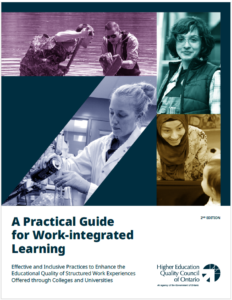
A Practical Guide for Work-integrated Learning was revised and updated in 2024!
To read the new edition, click here.
New guide helps practitioners enhance the quality of work-integrated learning opportunities
Work-integrated learning (WIL) is becoming increasingly popular in higher education; almost half of Ontario’s postsecondary education students will take part in some form of co-op, placement or internship by the time they graduate. A new guide from the Higher Education Quality Council of Ontario (HEQCO) and Education at Work Ontario (EWO) is a resource for faculty, staff, academic leaders and educational developers to improve the quality of WIL programs. Effective, work-integrated learning opportunities enhance student learning and develop work-ready skills outside of the classroom.
A Practical Guide for Work-integrated Learning: Effective Practices to Enhance the Educational Quality of Structured Work Experiences Offered through Colleges and Universities focuses on structured work-integrated learning experiences such as internships, placements, co-ops, field experiences, professional practice and clinical practicums. The comprehensive guide is divided into seven chapters with an introduction to experiential learning theory, followed by background information and suggestions on improving the quality of WIL programs, program evaluation and recommendations for broader curricular integration developing meaningful partnerships with industry, government and community organizations.
Authors of A Practical Guide for Work-integrated Learning: Effective Practices to Enhance the Educational Quality of Structured Work Experiences Offered through Colleges and Universities are Ashley Stirling and Gretchen Kerr, University of Toronto, and Jenessa Banwell, Ellen MacPherson and Amanda Heron.
Visit our work-integrated learning page to read more of HEQCO’s research on this topic.
